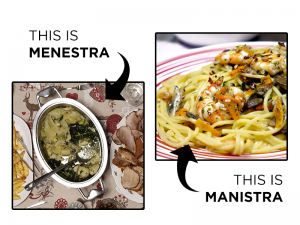Croatian dialects: 20 words for a ladle?
The basics of Croatian dialects
It might be surprising for foreigners, but Croatians sometimes don’t understand each other’s dialects, even if they live just a few kilometers apart. Croatian today includes three regiolects, Kajkavian, Chakavian and Shtokavian, and a large number of local dialects. Regiolects owe their names to their own versions of Croatian for “what”. These are što, kaj and ča (Shtokavian, Kajkavian and Chakavian, respectively).
 Shtokavian is spoken in the east regions of Croatia (such as Slavonia), and in some inland areas and parts of the Dalmatian coast. Chakavian is the most present in Istria, some areas of the coast, and particularly on Croatian islands. Kajkavian is spoken in Zagreb and the area around it, including the north-east and north-west of the country, as well as Gorski kotar, Croatia’s mountainous region.
Shtokavian is spoken in the east regions of Croatia (such as Slavonia), and in some inland areas and parts of the Dalmatian coast. Chakavian is the most present in Istria, some areas of the coast, and particularly on Croatian islands. Kajkavian is spoken in Zagreb and the area around it, including the north-east and north-west of the country, as well as Gorski kotar, Croatia’s mountainous region.
The variety in our dialects is like our coffee – we have a lot of it.
Our regiolects also mix and match, so it is sometimes hard to say which regiolect a dialect belongs to. For example, the Dubrovnik dialect is Shtokavian in some aspects, but the vocabulary is influenced by Italian. That’s why it is much closer to Dalmatian Chakavian. The whole thing is even more interesting than it sounds at first!
 Sometimes very similar words in one dialect can mean something else entirely in another. For example, manistra in Dalmatian Chakavian is a meal with pasta. But menestra in Dubrovnik is a very different meal. It is cured meats, potatoes and various kinds of green leafy vegetables.
Sometimes very similar words in one dialect can mean something else entirely in another. For example, manistra in Dalmatian Chakavian is a meal with pasta. But menestra in Dubrovnik is a very different meal. It is cured meats, potatoes and various kinds of green leafy vegetables.
Interestingly, pants are also sometimes problematic. While gaće in the south refers to pants, the same word means underpants in the northern area. Be careful with sentences like Imam samo dva para gaća, trebam nove (I only have two pairs of pants/underwear, I need new ones) – maybe the person you’re talking to might get confused!
Similarly, the same concept, such as a tomato, can have many different names. Rajčica (standard), paradajz (Kajkavian), pomadora (southern Shtokavian) or pomidora or poma (Chakavian) are all – tomatoes.
Our local dialects are also rich with words “loaned” from some other languages. A very interesting example is that of a ladle: There are about 20 varieties in our dialects! This includes šeflja or šefljenka from the German Schöpflöffel, kaciola, kaciol and kačica from Italian cazza or cazuolo, grabilica from Croatian grabiti (to grab, to spoon), kašika from the Turkish kaşik, and even kutljača from the Greek kotýle.
So here are 3 warm-up tips on Croatian local dialects
If you travel to Osijek and they call you lega, that means you are a good companion and are very welcome to come back.
You might find yourself chatting with some locals on the coast. If they offer you good spiza, you should not miss the opportunity to try out some of their local specialties.
If you want to get kajkavian and tell someone that you like them, you can use the expression: Imam te rad! and hope for the best. Que será, será! (or in kajkavian: Kaj bu, bu!).
To sum up, Croatian is quite a complex language. Our three regiolects have plenty of local dialects. This means that wherever in Croatia you decide to go, you are likely to learn a new word and enrich your Croatian word bank.
Of course, we can help you learn this wonderful and diverse language – take part in our Fast Croatian Course for foreigners and find out much more on this interesting topic!
Want to find out more? Contact us!
Spare yourself a phone call and leave us your contact info – we’ll contact you as soon as possible!





